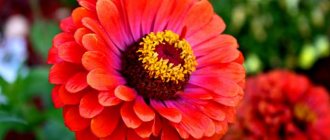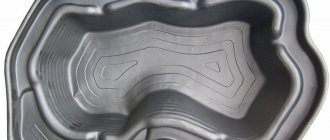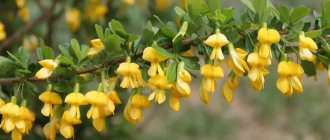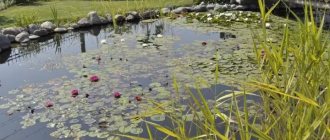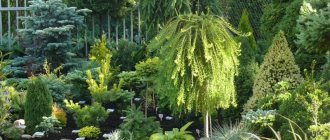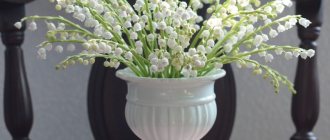No artificial reservoir can do without underwater plants. But why are they needed if they do not serve any decorative function?
Oxygenating plants play an important role in keeping the pond clean. Therefore, they are planted in a reservoir solely for the purpose of water purification. These plants do not allow pathogenic microorganisms to develop in the pond, which can lead to diseases of the flora and fauna of the artificial reservoir.
Also, during the process of photosynthesis, oxygenators are able to release oxygen and take organic particles and microelements from the water, which helps to establish biological balance in the pond. Oxygenators are predominantly underwater plants, but among them there are also specimens with beautiful leaves and even flowers.
The main problem that can arise with oxygenating plants is that most of them grow very quickly. Therefore, in order to prevent them from taking over the entire reservoir, they should be regularly thinned out or trimmed.
For a small pond, as a rule, 1-2 oxygenating plants are enough. If the reservoir is large, more plants will be needed. It is not difficult to place these species in a pond; some of them can even be taken from a natural reservoir. Plants are planted either in the soil at the bottom of the pond, or in containers, which are then lowered into water. The most popular oxygenating plants include elodea , swampweed , floating pondweed , hornwort , turcha and water moss .
Elodea
This aquatic plant is also known as "water plague". This is because it grows very quickly. However, Elodea's ability to purify water significantly overshadows this drawback. The plant is easily recognized by its long, bright green shoots with small lanceolate leaves and white flowers that appear in the summer.
Elodea prefers stagnant water and a temperature of about 20°C. Since the plant can live at a depth of 20 cm to 3 m, it can be planted both in coastal areas and in deep water. Elodea does not require special care, except that it needs to be thinned out periodically.
Possible difficulties and illnesses
Possessing strong natural immunity, pistia cannot always resist poor care. It is difficult for adult plants to cope with fungal diseases.
If its leaves turn yellow , look for the cause in a lack of lighting.
In addition, such a reaction may occur due to medications added to the water to treat the fish.
We’ll also tell you why pistia gets smaller in the aquarium . The plant may be lacking nutrients.
Adult bushes of water lettuce gradually degrade, so experienced aquarists advise renewing the plantings and thinning them regularly.
Swampman
The plant looks like green cushions located at the bottom of the pond, from which rosettes of leaves floating on the surface extend. In summer, small flowers can be seen on the swamp grass. But they do not have any decorative value; green rosettes of brightly colored leaves look much more impressive in the water.
Swampweed is an annual small plant 5-20 cm long. It likes to grow in slowly flowing or standing water, so it is ideal for an artificial pond. Swampweed is usually planted in shallow water or in a swampy area. When placing a plant in a pond, it is important to provide it with sunny or partial shade. Marshweed is an ideal aquatic species for small bodies of water.
Habitats and applications
The main places of growth are South America and Africa, found in the waters of India and China.
The population of these regions uses the plant for medicinal purposes to combat sexually transmitted diseases, skin diseases and dysentery.
It is in demand in agriculture, where it is used to make fertilizer and feed pigs.
Layered pistia grows very quickly, filling the entire water space (see photo), which is why it is classified as a weed.
Active reproduction of the plant leads to swamping of water bodies, as a result, their inhabitants suffer and problems are created for navigation.
As an aquarium plant, pistia brings many benefits: it improves its decorative appearance, its roots collect suspended matter, filtering water .
In addition, it purifies water from heavy metal salts and serves as a shelter for small fish.
Interesting! When asked whether pistia is an algae or a plant, botanists answer that it belongs to plants, but behaves like an algae.
Hornwort
The perennial plant is quite common in the middle zone. Hornwort has long stems that branch at the top. The leaves are dissected narrow threads. The plant is suitable for deep-sea zones and can grow even at depths of up to 9 m.
Hornwort will thrive in both shade and sun, but it does not like too much light. The plant can overwinter directly in a pond: its upper part dies off, and the buds sink to the bottom.
What types of hydroclays are there?
Water lily
Photo: Water lily hydrocleis
Hydrocleis nymphoides is an aquatic perennial herbaceous plant with floating and incipient leaves that take root along the stolons at the nodes; stems stretching, up to several meters in length. All leaves, which appear at the base or in clusters along the stem at nodes, are ovate, broadly ovate or elliptic, base with a shallow core, apex obtuse or rounded, length 3–13.5 cm, width 3–12 cm; dark green and glossy above, paler below, with 2-4 parallel longitudinal veins on either side. The petioles grow 10–40 centimeters long, up to 8 millimeters in diameter, fragile, transversely ribbed, with externally noticeable internal partitions; bracts mostly with alternating petioles and peduncles, membranous, ovate to lanceolate, up to 6.5 centimeters long.
— Advertising —
The inflorescences are simple, with single flowers in the leaf axils, arising in the stolon nodes; peduncles up to 30 centimeters long.
Photo: Two growing water lilies.
The flowers are incipient, 5–8 cm in diameter, short-lived, blooming for 1–2 days. There are 3 sepals, they are green, shiny, narrowly ovoid or elliptical, 15–20 millimeters long, 6–10 millimeters wide, longitudinally striped, with a membranous, translucent wing along the edge. The petals grow tuberous, but often open outward, widely inversely rounded-triangular or rounded-rhombic, 30–40 millimeters long, 30–50 millimeters wide; delicate, cream, pale yellow or yellow, sometimes white; often deeper yellow towards the base, the resin oil points are pale yellow or reddish in color. Stamens numerous, external sterile; the anthers of the lobes are yellowish. The fruit is 15 millimeters long.
Marty
Photo: Hydrocleis Martii
Hydrocleis martii is an aquatic plant with stems up to 50 centimeters in length. The leaves grow from wide ovate to round, 12-10 centimeters, juicy green. The base is heart-shaped, the tip is blunt or pointed. There are 5-7 veins visible on the leaf. Inflorescence with 1-6 flowers up to 30 centimeters long. Flowers up to 5 cm yellow-golden in color. Seeds are 1 millimeter long.
The above mentioned species are not very attractive to aquarists due to the growth of large floating leaves. They grow well in a pond or small pond with low water levels, in a well-lit and warm place. Under such conditions, individuals produce not only floating leaves, but also leaves that rise above the water level. Light green flowers often appear.
Pondweed floating
This perennial, like many oxygenating plants, not only enriches the water with oxygen, but also provides a haven for fish. Place the plant in the deepest part of the pond, where it is immersed in a container or planted directly into the ground, pressing the cuttings with a weight.
Pondweed grows well in the sun, but it can also be kept in partial shade. The oval leaves of the elongated shoots of the plant are on the surface, and individual parts can come off and float freely on the surface of the pond. The only problem with floating pondweed is that its growth is extremely difficult to limit.
Keeping in an aquarium
Pistia teloresidae does not have any special requirements for the basic parameters.
For normal development, it needs a temperature of 25...28 ° C ; at lower values, the plant’s rosette decreases.
View this post on Instagram
Posted by Alexander (@beketovplants) July 31, 2022 at 1:58 PDT
Water parameters
There are no clear boundaries for water salad in terms of acidity and hardness of water. The most comfortable parameter is 7 pH.
If the value drops below 5 pH, plant growth slows down until it completely stops and gradually withers.
Lighting
Water lettuce loves the sun. If they decorate a garden pond, it is important that the pond itself is well lit.
When placing pistia in an aquarium, it is necessary to create a 12-hour lighting regime.
You cannot use incandescent lamps for this; they heat up and can burn the leaves of the plant. Luminescent types with high power are suitable.
Interesting! If the pistia is satisfied with the length of daylight, it closes the outlet at night and opens it in the morning.
Priming
For a floating plant - and water lettuce is one of these - the presence of soil in the aquarium is not important .
However, if the soil is fertile and the roots of the pistia reach it, the plant develops faster and looks more beautiful.
Feeding
For a comfortable existence of the pistia in the aquarium, it can be fed with complex fertilizers . Dosage - 2 g per 100 liters of water.
They are added every week from spring until the end of summer. Before introducing the next portion, the water in the aquarium must be replaced.
Winter dormancy period
Despite the more than comfortable conditions in the aquarium, pistia lives according to the laws of nature, and in winter it begins a period of rest .
Already at the end of summer it stops growing, the foliage falls off, and only a few small leaves remain on the rosette.
To properly transition the plant into a dormant state, it is necessary to lower the water temperature, which will certainly have a bad effect on the fish. That is why pistia is transferred to a separate container for the winter .
The temperature in it is gradually lowered, bringing it to a level of 17...19 °C. They reduce both the light regime and the frequency of water changes, and remove fertilizing.
Important! If water lettuce is not transferred to a winter routine, it will die.
Conferva
Fontinalis, as this plant is also called, grows quite slowly compared to most oxygenators. Nevertheless, in terms of cleansing functions, it is not inferior to other plants in the group.
Water moss thrives in sun and partial shade. It is recommended to plant the plant in a pond with fish, because they lay eggs on the thin long stems of fontinalis. The leaves of the plant are dark green and elongated. Water moss can be propagated by dividing the bush, which is best done in spring or summer.
Flora of reservoirs, which is a source of oxygen
Considering that plants can be multifunctional in purpose, it is advisable to use those that purify water. How does this happen? Minerals and carbon dioxide are absorbed. Algae do not have the opportunity to reproduce unhindered. How can you choose a “pond dweller” who will perform all the necessary functions and not cause any trouble? These include hornwort, elodea, urut, and pondweed. The only thing they need is to be dropped off. They take care of the rest. But you need to pay attention to their characteristics, since some of them, for example, elodea, can grow over the entire pond, displacing everything around them. To prevent this from happening, such plants should be planted in small quantities.
Turcha
This oxygenator differs from many representatives of the group in its ability to bloom brightly. Turchi flowers appear on peduncles that grow up to 20-25 cm in height and rise above the surface of the water surface of the pond. White or pale purple flowers are at the very top of the peduncles.
The feathery leaves of the plant are bright green in color. In the fall they die off, and the turkish buds safely overwinter in the pond. The plant can be propagated by cuttings, which is best done in the summer.
Other oxygenating plants for a garden pond: swampweed, water buttercup, tillea, urut, hara, telores.
Remember that oxygenating plants are very useful for a pond, therefore, when organizing a pond on your site, do not forget to plant elodea, hornwort or water moss in it.
Features of wintering aquatic plants
It must be remembered that small garden or country ponds, created with your own hands using containers built into the ground, are subject to freezing in winter.
In order to save plants from freezing in winter, they must be moved for wintering to specially prepared places for this purpose, namely:
- plants growing in baskets are moved to a warm room (basement or other frost-free room), into a container with water, providing water supply;
- free-floating plants are moved to a warm aquarium or other container suitable for this purpose.
Rules for planting aquatic plants
Let's look at the main points:
- The preferred option for planting aquatic plants is container planting or mesh baskets.
- The most favorable time for planting aquatic plants is late spring - early summer.
- When preparing the soil for planting, you need to mix clay and peat in a 2/1 ratio, add fertilizer and mix, moisten with water.
- Pour the prepared soil into the bottom of the container (basket).
- Place the plant in a container (basket), after removing dry and dead leaves and other parts from it.
- Straighten the root system of the plant, distributing it evenly throughout the container (basket).
- Carefully fill the plant with soil up to the root collar and compact the soil around it well.
- Cover the top of the soil with pebbles about a couple of centimeters high, then you can put larger decorative stones.
- In order to make it convenient to lift or release the container (basket) into the pond, attach a fishing line to it in 3-4 places.
- Carefully release the container (basket) into the water so as not to disturb the plant and soil; first, do not lower the container (basket) deeply (bring the ends of the fishing line to the shore, decorating them with any object convenient for you).
We hope that, knowing these plants for a pond at your dacha, you will be able to organize a beautiful pond in your garden!!!
Save the article on your favorite social network so as not to lose:
Rules of care
Plants and water conditions must be constantly monitored.
- To prevent excessive growth of floating plants, the pond must be thinned. The small duckweed is eaten by the fish themselves, and some die off naturally. Rotting parts of the plant must be removed.
- Rot tends to infect neighboring plants. And besides, it spoils the whole beautiful picture of reservoirs. The water surface can be treated with special reagents.
- To remove leaves, insects and other debris, you need to have a regular net on hand. Garden debris that falls into a pond blocks the light for deep-sea plants.
The mini-biosystem will eventually establish equilibrium. At the initial stage, she needs help. You can design the pond yourself and use ready-made options from photographs as a basis.
Growth cycles
During the growing season of pistia, there is a clear change in growth cycles. Their alternation depends on the length of daylight hours. As the number of daylight hours increases, active growth begins and a large amount of young vegetative mass emerges from the rosette. Over time, the rosette increases in diameter, and one or more layers grow on its periphery.
Closer to autumn, when daylight hours are reduced, growth stops, and the phenomenon of leaf fall is partially observed - large leaves fall off, and only small ones remain, to which the plant can provide nutrition in the winter. Until next spring, metabolic processes slow down.
